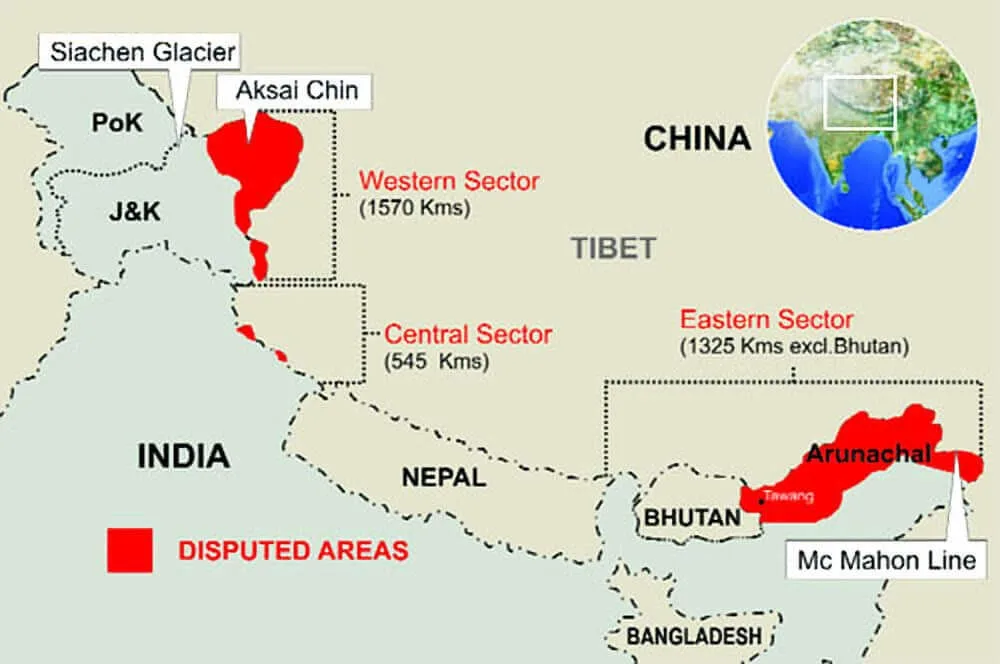Syllabus: GS2/International Relations; India and its Neighbour
Context
- Recent developments have highlighted the delicate balance trying to maintain in the relationship between China and India which is complex and multifaceted, marked by cooperation and conflict by both countries.
Historical Context
- The China-India relationship has been historically strained, primarily due to border disputes.
- The most notable conflict occurred in 1962, and tensions have periodically flared up since then, most recently with the Galwan Valley clash in 2020, which resulted in casualties on both sides.
- Since then, both countries have engaged in numerous rounds of diplomatic and military talks to de-escalate the situation, but with limited success.
| Line of Actual Control (LAC) – The LAC is the demarcation that separates Indian-controlled territory from Chinese-controlled territory. – India considers the LAC to be 3,488 km long, while the Chinese consider it to be only around 2,000 km. – It is divided into three sectors: 1. the eastern sector which spans Arunachal Pradesh and Sikkim; 2. the middle sector in Uttarakhand and Himachal Pradesh,and; 3. the western sector in Ladakh. – LAC in the eastern sector consisting of Arunachal Pradesh and Sikkim is called the McMahon Line which is 1,140 km long. Major friction points along the India-China border – Depsang Plains: This area is located in the northernmost part of Ladakh and has seen incursions by Chinese troops in the past. – Demchok: This area is located in eastern Ladakh and has seen disputes over the boundary between India and China. – Pangong Lake: This area has been a major flashpoint between the two countries, with Chinese troops attempting to change the status quo on the LAC in the region. – Gogra and Hot Springs: These two areas are located in eastern Ladakh and have seen standoffs between Indian and Chinese troops in recent years. – Arunachal Pradesh: This northeastern Indian state is claimed by China as part of its territory and has been a major point of contention between the two countries. How is the LAC different from the Line of Control with Pakistan? – The LoC emerged from the 1948 ceasefire line negotiated by the UN after the Kashmir War. – It was designated as the LoC in 1972, following the Shimla Agreement between the two countries. It is delineated on a map signed by DGMOs of both armies and has the international sanctity of a legal agreement. – The LAC, is only a concept and it is not agreed upon by the two countries, neither delineated on a map or demarcated on the ground. |

Recent Diplomatic Engagements
- The recent meeting of heads of states of India and China on the sidelines of the BRICS Summit in Kazan, Russia, marking their first bilateral talks in five years.
- Both leaders emphasised the importance of maintaining peace along the LAC and agreed on the need for mutual trust, respect, and sensitivity in their interactions.
- The recent agreement, as reported, involves the restoration of patrolling rights in the Depsang Plains and Demchok in Ladakh, areas that have been flashpoints in the ongoing conflict.
- It is seen as a first concrete step towards restoring the pre-2020 status quo ante. Additionally, agreements have been reached in other sectors along the LAC, including Arunachal Pradesh.
Significance
- Border Stability: The situation along the India-China border remains a critical issue. Despite recent diplomatic engagements, the border situation is described as ‘generally stable’ but still requires careful management.
- Both countries have agreed to put the boundary issue in an ‘appropriate position’ and promote its transition to ‘normalised management’.
- Economic and Strategic Interests: Beyond the border disputes, China and India have significant economic and strategic interests that necessitate cooperation.
- Both countries are key members of the BRICS and the Shanghai Cooperation Organization (SCO), and their cooperation is vital for regional stability and economic growth.
- It opens up diplomatic space for India as it navigates its relationships with major global powers, including Russia and the West.
- Political Engagement: A potential meeting between Indian Prime Minister and Chinese President on the sidelines of the Shanghai Cooperation Organisation (SCO) summit could further solidify this agreement and outline future political and economic engagements.
Challenges Ahead
- Implementation: The disengagement process must be followed by de-escalation and de-induction, which will be a slow and complex process requiring constant vigilance.
- Trust Deficit: The relationship between India and China has been marred by a significant trust deficit. Building confidence and ensuring compliance with the agreement will be critical.
- Broader Issues: The border issue is just one aspect of the complex India-China relationship. Broader issues, including trade imbalances and geopolitical rivalries, need to be addressed to achieve lasting peace and stability.
- Since the 1980s, India and China have sought peaceful resolution of their boundary dispute. Informal summits between leaders, like those in Wuhan (2018) and Chennai (2019), emphasised strategic communication and cooperation.
- The unresolved boundary issue remains a point of contention, leading to occasional tensions.
Conclusion and Way Ahead
- The India-China agreement to restore patrolling rights and begin the disengagement process is a welcome step towards breaking the stalemate.
- It reflects the patience and fortitude of India’s diplomatic and security establishments.
- While recent diplomatic efforts have shown promise, the path to a stable and cooperative relationship will require sustained dialogue, mutual respect, and a commitment to resolving longstanding issues.
Previous article
India-U.S. Ties Have Strong Foundation
Next article
Reducing Dependence on the Import of the Coking Coal